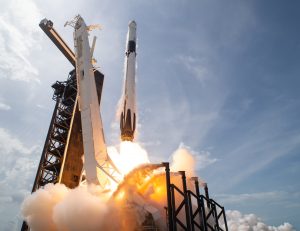On May 30, SpaceX launched American astronauts into space in its Dragon Endeavor spacecraft, a first for the company and a first for the private sector. For NASA and the broader U.S. space community, this was also a special moment because the United States was sending its astronauts to space from its own soil after many years. Since shutting down its space shuttle program in 2011, the United States had relied on Russia to send American astronauts to space. SpaceX’s launch heralds a new beginning for the U.S. in its human spaceflight missions.
The mission is also significant in that it sets the stage for U.S. missions to the moon and Mars. The U.S. is set to return to the moon in the next few years, but no date has been set for a future Mars mission. Prior to the recent launch, NASA Deputy Administrator Jim Morhard said, “We’re at the dawn of a new age. We’re leading the beginning of a space revolution.” Following the successful launch, Jim Bridenstine, the NASA administrator, spoke about the U.S. moon mission, the Artemis program, saying, “We don’t want to go [to the moon] alone. We want to go with international partners and we want to go with @Commercial_Crew partners.”
This has been proud moment for the U.S. space program, as well as for ordinary citizens — #LaunchAmerica became a trending hashtag on social media. From Vienna, U.S. Ambassador Jackie Wolcott, representative of the United States to the Vienna Office of the United Nations, commented on the launch saying, “Collaboration with the private sector is essential in this new era of outer space exploration.”
This has been a key moment: The growing private space sector is beginning to create new energy and excitement about space, something that has been missing for a long time.
The NASA-SpaceX launch has been in the works for a while and has been closely watched by U.S. friends and adversaries alike. Back in the 1960s, it was essentially the United States and the Soviet Union that were capable of sending humans to space, but the situation is quite different today, with many more countries in the fray. China has an active human spaceflight program, having sent its first crewed mission to space in 2003. India also has plans to send its first astronauts to outer space in another two years. While space exploration and understanding the cosmos are important by themselves, today’s exploration programs, including the crewed missions, are a demonstration of growing competition in space, much like what happened during the Cold War. The U.S. return to having its own crewed mission is one more piece of evidence that this competition is intensifying.
NASA’s Commercial Crew Program is significant in a number of ways. First and foremost, it removes the U.S. dependency on Russia for sending American astronauts to space. U.S.-China competition may be getting all the attention, but mounting tensions between Russia and the United States in recent years also have ramifications in multiple domains, including outer space. The fact that Russia could stop cooperating in sending Americans into space using the Soyuz vehicle was always a possibility. It is also a major vulnerability that Washington would have liked to rectify so that they remain independent when it comes to ferrying American astronauts to space.
NASA’s new arrangement also brings in important economic benefits. For one, the United States can save on the cost of buying a seat on the Soyuz spaceship. It is reported that NASA has paid Russia around $86 million per seat to send astronauts to the International Space Station using the Soyuz spacecraft. SpaceX Crew Dragon on the other hand is a much cheaper option, costing NASA only around $55 million. Under NASA’s Commercial Crew Program, Boeing is also developing an astronaut taxi, the Crew Space Transportation (CST)-100 Starliner, that can carry seven passengers, or a mix of crew and cargo, into low Earth orbit. Boeing’s astronaut-ferrying taxi is likely to cost around $90 million per seat. In addition to potential direct savings per seat per astronaut, an American crew spaceship industry within the United States will also create an entire industry around it, thus creating a large number of jobs in the country in addition to gaining spin-off technological benefits.
There are also economic benefits in terms of creating a sustainable link between NASA and the private sector, thus helping the emergence of the private sector as a key stakeholder. These direct financial benefits and the indirect technological gains are crucial, especially at a time when great power competition is peaking once again. Additionally, these collaborations with commercial enterprises will help NASA accomplish much of its future plans for the moon, and possibly Mars at a later date.
Elon Musk, the founder of SpaceX, himself sees an active role on this. After the successful lift-off of the Crew Dragon, Musk said, “This is hopefully the first step on a journey toward a civilization on Mars.” An array of space industries is coming up, exploring the possibilities of space tourism within the decade. All of these mean economic and strategic advantage to the United States.

































